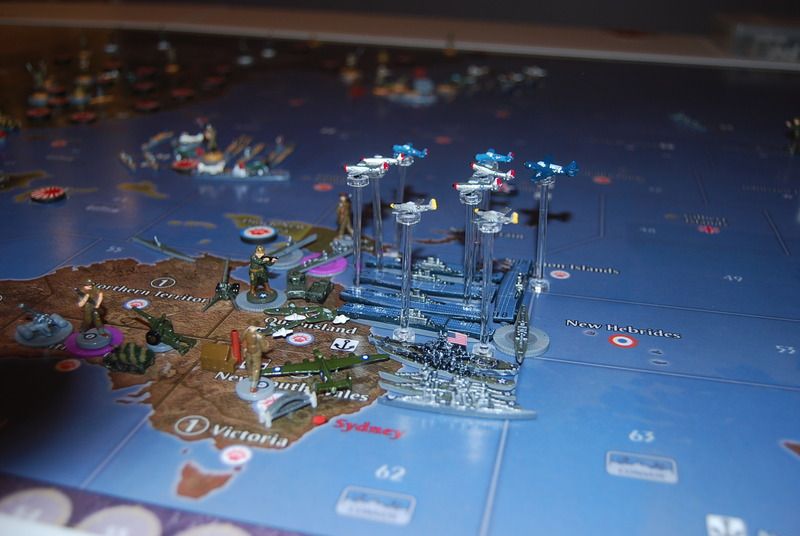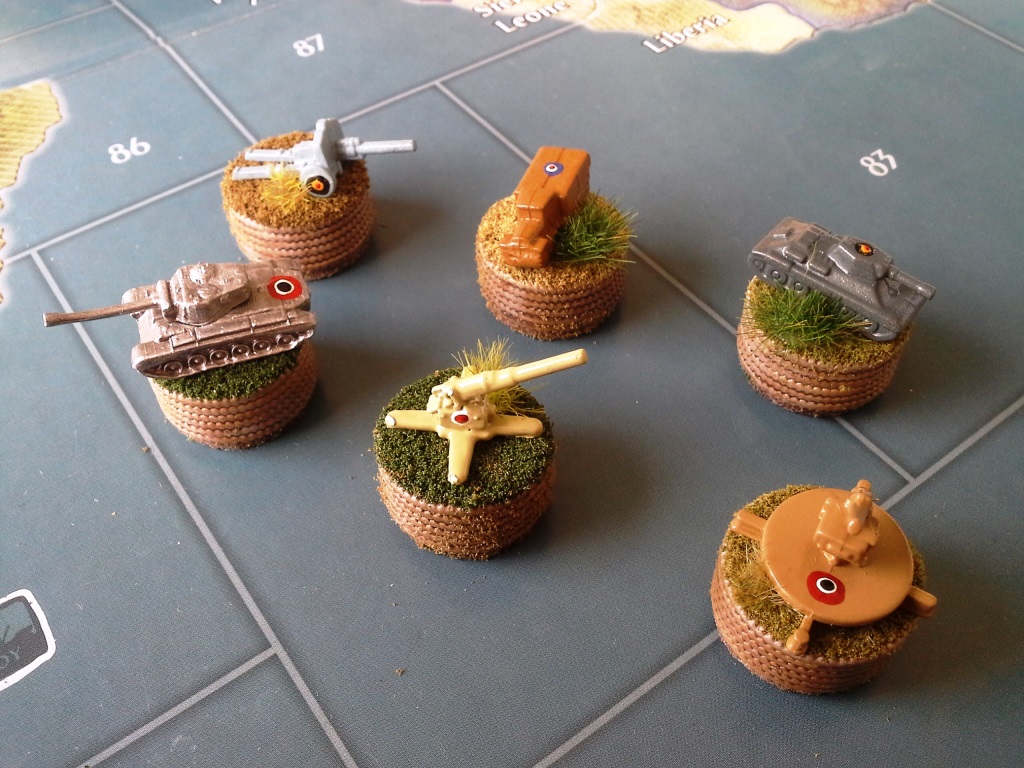This subject came up briefly yesterday in connection with another discussion thread. In case it might be of any interest, I took a couple of pictures and prepared the following more detailed description.
The original 2001 A&A Pacific game contained optional devices called task force markers, which consisted of six numbered plastic roundel holders and six corresponding numbered cards printed on stiff cardboard. (See the “Blocks as Markers” picture below for a photo of a roundel holder and its corresponding card, with a few ANZAC ships on top of the card.) Their purpose was to allow a whole group of ships to be represented on the game map by a single marker (the roundel holder), which is convenient for situations in which lots of ships need to be crammed into a tight space…for instance, if opposing forces with multiple ship types meet in one of the smaller sea zones, with adjoining land forces also needing to be represented in the same area.
These task force markers were a handy concept, but they had some limitations. First, there were only six of them. Second, they were limited to depicting groups of sea units, not land units or air units. Third, the plastic roundel holders weren’t as small as they could have been; they offered convenience, but not necessarily much of a space saving. And third, they were technically limited to the US, the UK and Japan.
When HBG came along about a decade later, the company produced a line of products which neatly solved these problems: various sets of land and naval task forces…
http://www.historicalboardgaming.com/Task-Force_c_438.html
…which consisted (for each of the nations depicted, each with a distinctive printed design) of a large card on which a group of sculpts could be gathered and a small token designed to be placed on the game map.
Prior to HBG’s development of these markers, however, I had worked out a home-brewed alternate method of depicting forces with markers, which is what I’ll be describing here.
I have a large collection of coloured square wooden blocks, each one measuring about 3/4 inch x 3/4 inch (2 x 2 cm). Their thickness isn’t consistent, but they tend to be about 1/4 inch thick (7 mm). Most of them come from the Command and Colors: Ancients line of game, and a few from the C&C: Napoleonics line. I have about 15 separate colours and shades in my collection, and as you’ll see from the “C and C Blocks” picture below some of these colours are good (or at least acceptable) counterparts to the A&A sculpt colours.
The blocks also happen to be almost exactly the same size as Scrabble tiles, which (of course) represent every letter of the alphabet, most of them in multiple copies. (The tiles have a small subscript number representing the point value of each letter, but this number can be ignored.)
As illustrated below, the C&C blocks and the Scrabble tiles can be combined to create force markers. Each force requires two block/tile pairings: one stacked pairing to go on the map (serving as a force marker), and one side-by-side pairing to be placed next to the group of actual plastic sculpts which are represented on the map by the force marker. Each group of sculpts, plus its identifying block/tile pairing, can either be placed on a stiff 3 x 5 index card (which is convenient for handling the sculpts as a group), or can be placed off the map (as shown below) on any available free surface. (Although not shown in the picture below, my customized Global 1940 table has wing extensions on each side of the map for just such purposes.)
The stacked block/tile pairings are about one-quarter the size of the original A&A roundel holders, so they’re easier to fit into a small sea zone or land territory. Unlike the roundel holders, which are blue and which feature a ship design, the stacked block/tile pairings are generic in appearance and therefore better suited to representing either sea unit groups or land units groups or air unit groups.
Strictly speaking, the coloured blocks aren’t necessary to make the concept work; the Scrabble tiles alone would suffice. Since I already have the blocks, however, I prefer to use them paired with Scrabble tiles rather than using Scrabble tiles alone, for two reasons. First, and most importantly, it adds a colour-identification element to the force marker on the map. If a tile alone was being used, players would need to look off the map to see what colour of sculpts was located next to the corresponding lettered tile, which is less convenient (especially if a large number of force markers is being used on the map; if it’s just a couple, then obviously it’s not much of a problem).
Second, it permits a greater potential number of force markers to be used. If tiles alone are used, only one player can use a given letter because there would be no way to distinguish visually between two forces both designated as (for example) “A”. This limitation isn’t a severe one in practical terms: 26 letters divided between, let’s say, 6 players, works out to 4 letters per player (plus a couple of leftover extras), which ought to be adequate. The block/tile pairings, on the other hand, offer enough potential pairings to satisfy any imaginable game requirements. Eight block colours (the US and China are both green, since I only have one shade of that colour), multiplied by 26 letters (assuming one owns multiple Scrabble games, which isn’t really necessary), works out to a theoretical maximum of 208 distinct block/tile pairings…which, to put it mildly, is a very comfortable safety margin, since these force markers are really only meant to be used in tight areas (rather than as a systematic replacement to having sculpts on the map itself, which is a big part of the fun of playing A&A as a physical board game).
















